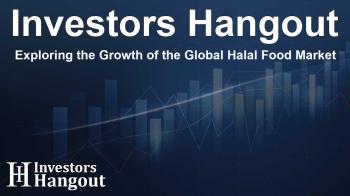Exploring the Growth of the Global Halal Food Market

Introduction to the Halal Food Market
The halal food market is experiencing remarkable growth globally. This positive trend can be attributed to the growing awareness of the health benefits associated with halal foods. Halal food and beverage products align with Islamic dietary laws, emphasizing cleanliness, safety, and ethical preparation methods, thus gaining traction among health-conscious consumers.
Significant Market Growth
Recent insights indicate that the halal food market is set to reach approximately USD 4.12 billion in the near future, up from USD 2.49 billion in previous years. This growth reflects a compound annual growth rate (CAGR) of around 7.6%. Consumers increasingly prioritize their health, leading them toward foods that not only meet dietary restrictions but also enhance their wellbeing. The process of halal slaughter, which ensures thorough blood drainage from the animal, contributes to superior meat quality, making halal products appealing for their high protein and low preservative content.
Rising Demand for Halal Food
Impact of the Growing Muslim Population
With Islam being one of the fastest-growing religions, comprising nearly 24% of the global population, the demand for halal foods is on the rise. This growing demographic not only seeks halal-certified products for religious reasons but also appreciates the ethical sourcing and health benefits that these products offer. The widespread availability of halal items worldwide is a direct response to this expanding consumer base.
Halal Tourism: A New Trend
Another dimension impacting the halal food market is the flourishing halal tourism sector. As more Muslim travelers seek food options that adhere to their dietary requirements, countries are adapting their offerings to attract this market. Destinations such as Malaysia and Indonesia are at the forefront, boasting robust halal tourism frameworks that cater specifically to Muslim visitors by providing a diverse array of halal culinary choices.
Geographical Insights into Market Leadership
As of recent reports, the Asia Pacific region is a dominant player in the halal food market, showing significant revenue contributions. Following closely are the Middle East & Africa and Europe, with the Middle East & Africa projected to showcase the highest growth rate during the upcoming years. This growth can be attributed to increasing investments in halal food infrastructure and the global inclination towards halal diets.
Market Segmentation Analysis
The halal food market can be segmented based on product type and distribution channels. The categories include prepared meals, snacks, packaged salads, and many others. Prepared meals, in particular, hold a major market share due to their convenience and widespread appeal. Distribution channels also play a crucial role; supermarkets and hypermarkets currently dominate the market due to their accessibility and variety of offerings.
Key Players and Competitive Strategies
The halal food market hosts a range of key players dedicated to enhancing product offerings and consumer outreach. Companies such as Nestlé S.A. and American Halal Company Inc. are instrumental in driving market dynamics through innovative product development. The increasing demand for halal-certified snacks and pre-packaged meals indicates significant growth potential, urging businesses to focus on e-commerce and online retail expansion.
Conclusion
In conclusion, halal food is crafted to meet high standards of cleanliness and ethical processes. As consumer awareness rises concerning food safety and the benefits of halal certification, the demand for halal products continues to surge, appealing not only to the Muslim population but to a broader audience eager for trustworthy food options. The ongoing growth in halal tourism is expected to further amplify this demand, presenting valuable opportunities for stakeholders across the food industry.
Frequently Asked Questions
What is the halal food market?
The halal food market encompasses food products prepared in accordance with Islamic dietary laws, ensuring their permissibility for Muslim consumers.
Why is the halal food market growing?
The growth of the halal food market is primarily driven by the increasing health consciousness among consumers, the expanding Muslim population, and the rise in halal tourism.
What are the key products in the halal food market?
Key products include prepared meals, snacks, sauces, and desserts that comply with halal standards, focusing on health and ethical sourcing.
How does halal certification impact food choices?
Halal certification assures consumers of safe and ethically prepared food, broadening its appeal beyond just Islamic dietary requirements to health-conscious individuals.
What regions lead the halal food market?
The Asia Pacific region currently leads the halal food market, with significant contributions also coming from the Middle East & Africa and Europe.
About The Author
Contact Dominic Sanders privately here. Or send an email with ATTN: Dominic Sanders as the subject to contact@investorshangout.com.
About Investors Hangout
Investors Hangout is a leading online stock forum for financial discussion and learning, offering a wide range of free tools and resources. It draws in traders of all levels, who exchange market knowledge, investigate trading tactics, and keep an eye on industry developments in real time. Featuring financial articles, stock message boards, quotes, charts, company profiles, and live news updates. Through cooperative learning and a wealth of informational resources, it helps users from novices creating their first portfolios to experts honing their techniques. Join Investors Hangout today: https://investorshangout.com/
The content of this article is based on factual, publicly available information and does not represent legal, financial, or investment advice. Investors Hangout does not offer financial advice, and the author is not a licensed financial advisor. Consult a qualified advisor before making any financial or investment decisions based on this article. This article should not be considered advice to purchase, sell, or hold any securities or other investments. If any of the material provided here is inaccurate, please contact us for corrections.

